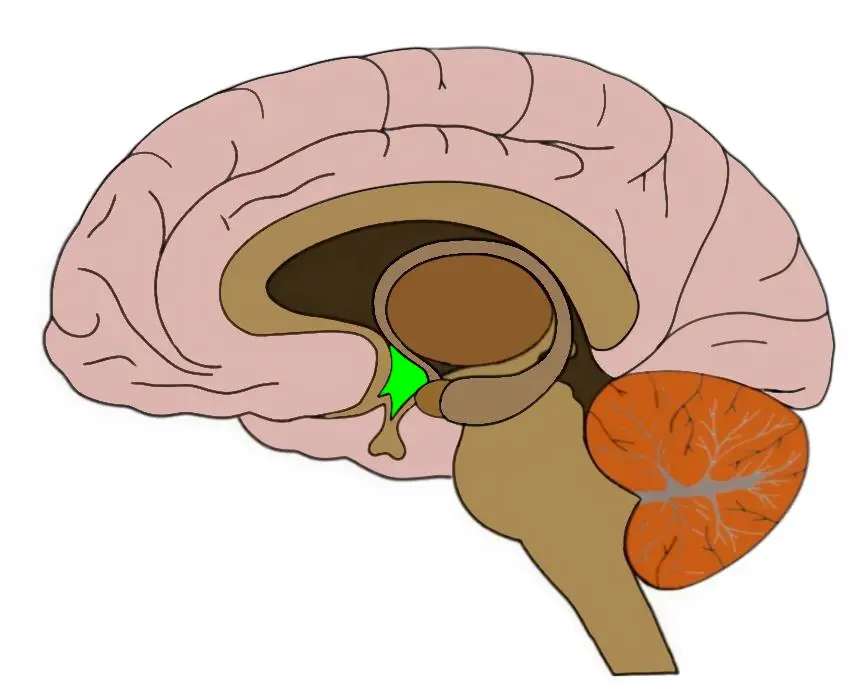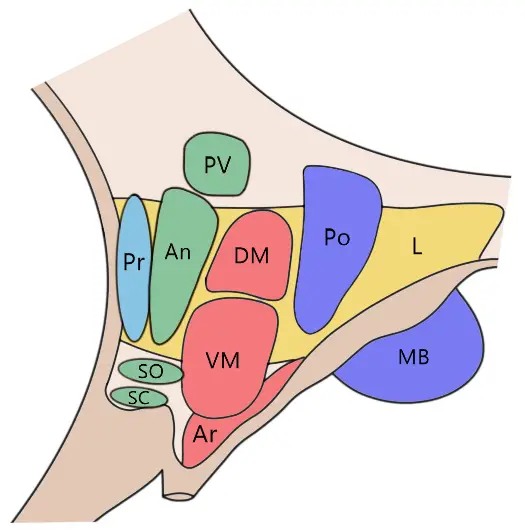Know your brain: Hypothalamus
Where is the hypothalamus?

The hypothalamus is a small (about the size of an almond) region located directly below the thalamus. It is buried deep within the brain and not visible without dissecting the brain.
What is the hypothalamus and what does it do?
The hypothalamus is a collection of nuclei with a variety of functions. Many of the important roles of the hypothalamus involve what can be referred to as the two H's: Homeostasis and Hormones.
Homeostasis is the maintenance of equilibrium in a system like the human body. Optimal biological function is facilitated by keeping things such as body temperature, blood pressure, and caloric intake/expenditure at a fairly constant level. The hypothalamus receives a steady stream of information about these types of factors. When it recognizes an unanticipated imbalance, it enacts a mechanism to rectify that disparity.
The hypothalamus generally restores homeostasis through three mechanisms. First, it has connections to the autonomic nervous system, through which it can send signals to influence things like heart rate, digestion, and perspiration. For example, if the hypothalamus senses that body temperature is too high, it may send a message to sweat glands to cause perspiration, which acts to cool the body down.
The second way the hypothalamus can restore homeostasis is through the control of hormone release from the pituitary gland. The pituitary gland is a hormone-secreting gland that sits just below the hypothalamus. It consists of two lobes called the anterior pituitary and the posterior pituitary. The hypothalamus secretes substances known as releasing hormones into blood vessels that travel to the anterior pituitary gland. Releasing hormones are so named because they cause the pituitary gland to release hormones into the systemic circulation of the body. Hormones released by the anterior pituitary due to signals from the hypothalamus (and their general role in parentheses) include growth hormone (growth), follicle-stimulating hormone (sexual development and reproduction), luteinizing hormone (testosterone production and reproduction), adrenocorticotropic hormone (stress/fear response), thyroid stimulating hormone (metabolism), and prolactin (milk production).
The hypothalamus also synthesizes a couple of non-releasing hormones: oxytocin and vasopressin (also known as anti-diuretic hormone). These are then sent to the posterior pituitary for release into the bloodstream. Oxytocin can act as a hormone and a neurotransmitter. It has important roles in facilitating childbirth (hence the use of Pitocin to induce labor) and lactation, but also has been the subject of a lot of recent research due to its hypothesized role in compassion and social bonding. Vasopressin's main functions are to control urine output and regulate blood pressure (although it also seems to play a part in social and sexual behavior).
The third way the hypothalamus can restore homeostasis is through influencing behavior. Its influences on behavior are complex, but it is generally thought that the hypothalamus contains circuitry that can increase the likelihood of responses that will help to achieve homeostasis.
The hypothalamus thus has widespread effects on the body and behavior. It is often said that the hypothalamus is responsible for the four Fs: fighting, fleeing, feeding, and fornication. Clearly, due to the frequency and significance of these behaviors, the hypothalamus is extremely important in everyday life.
More In-Depth Information
Nuclei of the hypothalamus
As mentioned above, the hypothalamus actually consists of a collection of nuclei, each of which have their own functional roles in the brain. In this section, I will briefly discuss the main hypothalamic nuclei and summarize some of their functions. It's important to note that this will not be a complete list of all of the nuclei in the hypothalamus, nor a thorough explanation of everything those nuclei are involved in (indeed, this could fill a book of its own). Also, some hypothalamic nuclei are subdivided into smaller nuclei; I will not go into that level of detail in this section. Finally, it's important to mention that the nuclei of the hypothalamus are paired structures, meaning there is one nucleus on either side of the midline of the hypothalamus. So, while below I will discuss individual nuclei such as the suprachiasmatic nucleus, this would be more accurately described as the suprachiasmatic nuclei because there are two of them.

The anterior (i.e., front) hypothalamus contains a region called the preoptic area, which contains several preoptic nuclei. Different nuclei of the preoptic area are involved in: the regulation of blood composition and volume (both through mechanisms of hormone release and through behavior such as drinking), the regulation of body temperature, sleep regulation, and reproductive behavior. You can read more about the preoptic area in this article: Know Your Brain: Preoptic Area.
The suprachiasmatic nucleus is a small region that sits at the base of hypothalamus, just above a structure called the optic chiasm (hence the name suprachiasmatic, for above the chiasm). The suprachiasmatic nucleus plays a critical role in regulating our circadian rhythms, or the 24-hour cycle that controls our bodily functions. To accomplish this, cells in the suprachiasmatic nucleus contain a molecular clock, which is powered by an elaborate mechanism of gene transcription. To learn more about the biological clocks in the suprachiasmatic nucleus, see this article: Know Your Brain: Suprachiasmatic Nucleus.
The supraoptic nucleus sits just above the suprachiasmatic nucleus. Cells in this region are involved in the production of the hormone vasopressin, which is then transported down to the posterior pituitary gland to be secreted into the bloodstream (see the section above for a discussion of vasopressin's functions).
The anterior nucleus is situated above the supraoptic nucleus; it is best-known for its role in the regulation of body temperature.
The paraventricular nucleus is involved in hormone synthesis and secretion. It produces oxytocin, which is then secreted from the posterior pituitary gland (see the section above for a discussion of oxytocin's functions). The paraventricular nucleus also produces corticotropin-releasing hormone (CRH), which prompts the secretion of adrenocorticotropic hormone from the anterior pituitary gland to initiate the stress response of the HPA axis. And it produces thyrotropin-releasing hormone, which causes the release of thyroid-stimulating hormone from the anterior pituitary gland.
The dorsomedial nucleus and ventromedial nucleus both have established roles in feeding behavior. Stimulation of the dorsomedial nucleus promotes eating and drinking, while stimulation of the ventromedial nucleus inhibits these behaviors. The ventromedial nucleus is sometimes referred to as the "satiety center." When this region is damaged in laboratory animals, they tend to experience an increased appetite and substantial weight gain. Damage to the dorsomedial nucleus causes a reduction in feeding and loss of weight.
The arcuate nucleus is situated below the ventromedial nucleus. It contains neurons that produce a number of hormones, such as releasing hormones that will control hormone release from the pituitary gland.
The posterior nucleus is found toward the rear of the hypothalamus. It is involved in a list of automatic responses, such as the regulation of blood pressure, the regulation of body temperature, and pupillary dilation.
The lateral nucleus contains neurons that produce a substance called orexin (also known as hypocretin). These neurons project to other areas of hypothalamus and various other regions of the brain, and they are involved in wakefulness and appetite.
The mammillary bodies are found on the inferior surface of the hypothalamus (the side of the hypothalamus that is closer to the brainstem). Although they are involved in a variety of functions, the mammillary bodies are best known for their role in memory. They are thought to act as a relay between the hippocampus and other areas, such as the thalamus. They may act as more than a simple relay, however, and make independent contributions to memory consolidation. You can read more about the mammillary bodies in this article: Know Your Brain: Mammillary Bodies.
References (in addition to linked text above):
Nolte J. The Human Brain: An Introduction to its Functional Anatomy. 6th ed. Philadelphia, PA. Elsevier; 2009.
Sanchez Jimenez JG, De Jesus O. Hypothalamic Dysfunction. [Updated 2021 Dec 24]. In: StatPearls [Internet]. Treasure Island (FL): StatPearls Publishing; 2022 Jan-. Available from: https://www.ncbi.nlm.nih.gov/books/NBK560743/
Saper CB, Lowell BB. The hypothalamus. Curr Biol. 2014 Dec 1;24(23):R1111-6. doi: 10.1016/j.cub.2014.10.023. Epub 2014 Dec 1. PMID: 25465326.


